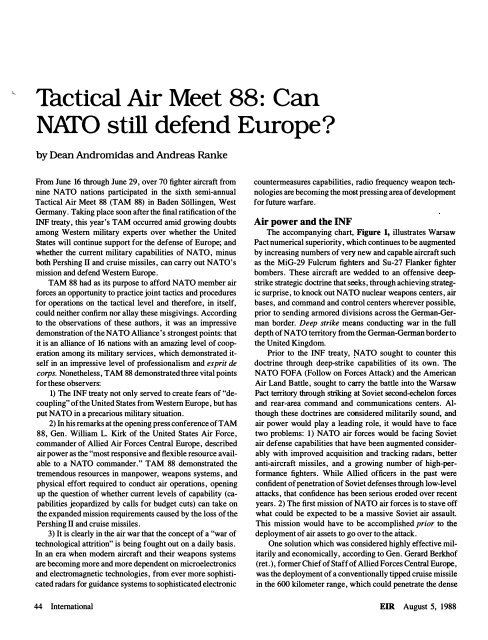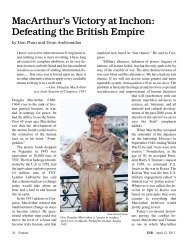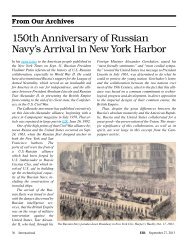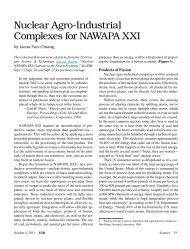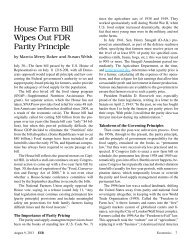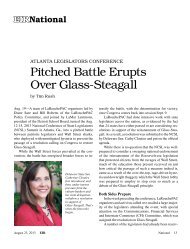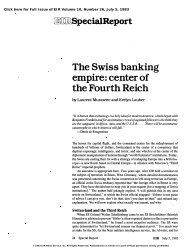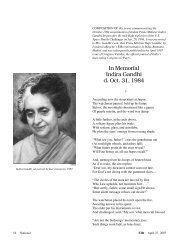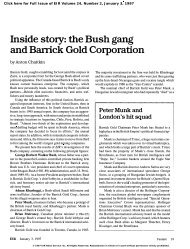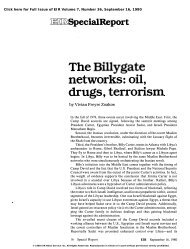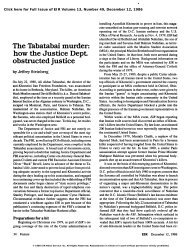View Full Issue - Executive Intelligence Review
View Full Issue - Executive Intelligence Review
View Full Issue - Executive Intelligence Review
Create successful ePaper yourself
Turn your PDF publications into a flip-book with our unique Google optimized e-Paper software.
Thctical Air Meet 88: Can<br />
NATO still defend Europe?<br />
by Dean Andromidas and Andreas Ranke<br />
From June 16 through June 29, over 70 fighter aircraft from<br />
nine NATO nations participated in the sixth semi-annual<br />
Tactical Air Meet 88 (TAM 88) in Baden Sollingen, West<br />
Germany. Taking place soon after the final ratification of the<br />
INF treaty , this year's TAM occurred amid growing doubts<br />
among Western military experts over whether the United<br />
States will continue support for the defense of Europe; and<br />
whether the current military capabilities of NATO, minus<br />
both Pershing II and cruise missiles, can carry out NATO's<br />
mission and defend Western Europe .<br />
TAM 88 had as its purpose to afford NATO member air<br />
forces an opportunity to practice joint tactics and procedures<br />
for operations on the tactical level and therefore, in itself,<br />
could neither confirm nor allay these misgivings. According<br />
to the observations of these authors , it was an impressive<br />
demonstration of the NATO Alliance's strongest points: that<br />
it is an alliance of 16 nations with an amazing level of cooperation<br />
among its military services, which demonstrated itself<br />
in an impressive level of professionalism and esprit de<br />
corps. Nonetheless, TAM 88 demonstrated three vital points<br />
for these observers:<br />
1) The INF treaty not only served to create fears of "decoupling"<br />
of the United States from Western Europe, but has<br />
put NATO in a precarious military situation.<br />
2) In his remarks at the opening press conference ofT AM<br />
88, Gen. William L. Kirk of the United States Air Force,<br />
commander of Allied Air Forces Central Europe, described<br />
air power as the "most responsive and flexible resource available<br />
to a NATO commander." TAM 88 demonstrated the<br />
tremendous resources in manpower, weapons systems, and<br />
physical effort required to conduct air operations, opening<br />
up the question of whether current levels of capability (capabilities<br />
jeopardized by calls for budget cuts) can take on<br />
the expanded mission requirements caused by the loss of the<br />
Pershing II and cruise missiles.<br />
3) It is clearly in the air war that the concept of a "war of<br />
technological attrition" is being fought out on a daily basis.<br />
In an era when modem aircraft and their weapons systems<br />
are becoming more and more dependent on microelectronics<br />
and electromagnetic technologies, from ever more sophisti<br />
cated radars for guidance systems to sophisticated electronic<br />
44 International<br />
countermeasures capabilities, radio frequency weapon technologies<br />
are becoming the most pressing area of development<br />
for future warfare.<br />
AJr power and the UNF<br />
The accompanying chart, Figure 1, illustrates Warsaw<br />
Pact numerical superiority, which continues to be augmented<br />
by increasing numbers of very new and capable aircraft such<br />
as the MiG-29 Fulcrum fighters and Su-27 Flanker fighter<br />
bombers . These aircraft are wedded to an offensive deepstrike<br />
strategic doctrine that seeks, through achieving strategic<br />
surprise, to knock out NATO nuclear weapons centers , air<br />
bases, and command and control centers wherever possible,<br />
prior to sending armored divisions across the German-German<br />
border. Deep strike means conducting war in the full<br />
depth of NATO territory from the German-German border to<br />
the United Kingdom.<br />
Prior to the INF treaty, NATO sought to counter this<br />
doctrine through deep-strike. capabilities of its own. The<br />
NATO FOFA (Follow on Forces Attack) and the American<br />
Air Land Battle, sought to carry the battle into the Warsaw<br />
Pact territory through striking at Soviet second-echelon forces<br />
and rear-area command and communications centers. Although<br />
these doctrines are considered militarily sound, and<br />
air power would play a leading role, it would have to face<br />
two problems: 1) NATO air forces would be facing Soviet<br />
air defense capabilities that have been augmented considerably<br />
with improved acquisition and tracking radars , better<br />
anti-aircraft missiles, and a growing number of high-performance<br />
fighters. While Allied officers in the past were<br />
confident of penetration of Soviet defenses through low-level<br />
attacks , that confidence has been serious eroded over recent<br />
years. 2) The first mission of NATO air forces is to stave off<br />
what could be expected to be a massive Soviet air assault.<br />
This mission would have to be accomplished prior to the<br />
deployment of air assets to go over to the attack.<br />
One solution which was considered highly effective militarily<br />
and economically, according to Gen. Gerard Berkhof<br />
(ret.), former Chief of Staff of Allied Forces Central Europe,<br />
was the deployment of a conventionally tipped cruise missile<br />
in the 600 kilometer range, which could penetrate the dense<br />
EIR August 5, 1988


